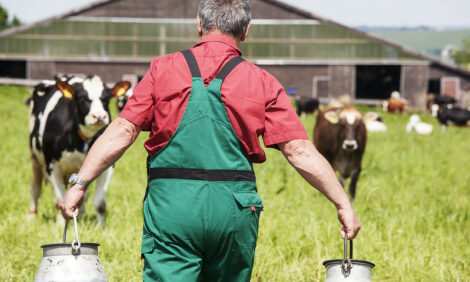



Air Quality Inside Livestock Buildings
CANADA - Improving air quality results in improved human respiratory response, health and wellbeing, and improved animal production performance. Many producers may not be aware of the implication and potential impact of indoor air quality on human and animal health, nor how air quality contributes to the deterioration of equipment and building components.“Air quality is defined as the degree of pollution in air,” says Dr. Atta Atia, manure specialist with Alberta Agriculture, Food and Rural Development, Edmonton. “Clean air is air that is free from any impurities. The more pollutants present, the lower the air quality. When calculating the quality of air in livestock buildings, air pollutants being assessed include various gases, micro-organisms that are often referred to as bioaerosols, and dust particles.”
There are as many as 160 gases that can develop when storing and handling animal manure. The most important in terms of health and safety of producers are ammonia, hydrogen sulphide, and methane.
“When working in livestock buildings that are occupied by livestock or humans, it is imperative to remember that agitation of manure stored in pits under the building can be fatal because of the release of gases,” says Atia.
“These gases are either toxic or capable of displacing the oxygen in the building. Enclosed livestock buildings must be ventilated, even on cold winter days, to remove moisture and gases.”
Ammonia has irritant properties. It has a pungent, acrid odour at concentrations larger than 0.7 parts per million (ppm). High concentrations, those that are above recommended thresholds of ammonia inside animal confinement buildings, pose serious potential hazards to humans and animals. In Alberta, the Threshold Limit Value (TLV) for ammonia exposure is 25 ppm (based on an eight-hour weight average).
Hydrogen sulphide is detectable as an odour as low as0.005 ppm. TLV for hydrogen sulphide exposure is 10 ppm (based on eight-hour weight average). Exposure to hydrogen sulphide concentrations of 2,000 ppm for even a few minutes can be fatal. Long exposures at 300 ppm have also caused deaths.
Methane is extremely difficult to detect without gas detection instruments. In confinement livestock housing, concentrations of methane are normally well below the explosive levels; however, explosions attributed to methane have occurred around manure storage pits that do not have proper venting.
“Bioaerosols can cause or trigger respiratory diseases in humans and animals,” cautions Atia. “Bioaerosols include microorganisms such as bacteria, viruses, fungi and actinomycetes. Compounds such as endotoxin, mycotoxin, aflatoxin, are also associated with these microorganisms. Bioaerosols vary greatly in size, ranging from 0.02 to 100 micron in diameter.
“Bioaerosols, or dust in livestock buildings is generated from feed, bedding, dried manure, skin debris and building materials. Respirable dust can be any airborne particles that are less than 10 micron in diameter and are easily trapped in the upper and lower airways. Respirable dust can have adverse effects on both the animals and workers health.”
The emissions of these pollutants depend on many factors such as temperature, humidity, ventilation rates, housing systems, manure management systems, and animal characteristics (species, size and density). Effective reduction of overall emissions of these pollutants will most likely include several of control strategies rather than any single one. Producers needing more information on emission reduction strategies are encouraged to contact Atia at (780) 427-4215.
The Environmental Practice Unit (EPU) and the Farm Safety Program of Alberta Agriculture have teamed-up to develop resources to educate producers about air quality and the risks of exposure to harmful pollutants found inside livestock buildings. These resources include and a number of factsheets and Lung 4 Life air quality display.
TheCattleSite News Desk


